by Norman Nabney
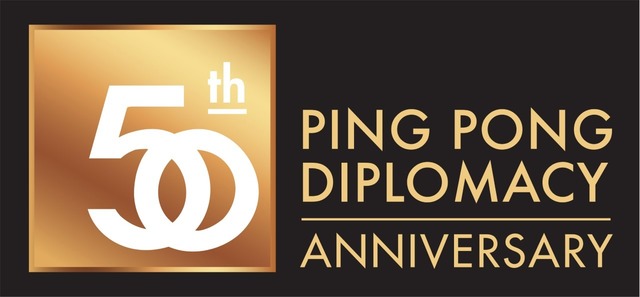
How it all started: At the 1971 World Championships staged in the Japanese city of Nagoya, Glenn Cowan, a young member of the United States team mistakenly boarded the bus carrying the Chinese team. Zhuang Zedong, the team’s greatest player, greeted him through an interpreter. Photographers caught the incident on film. The political climate in the 1960s was such the sight of Chinese and American athletes together was headline news. The unexpected goodwill between the U.S. and Chinese teams soon became the talk of the tournament.
Following the sensational news, Mao Zedong, President of the People’s Republic of China, decided to invite the United States table tennis team in China. Members of the United States table tennis team, alongside accompanying members of the media, arrived in China in April 1971 to visit the country and play friendly matches. They were the first American delegation to visit the Chinese capital city of Beijing since 1949. Touted as one of the greatest diplomatic breakthroughs of that era, table tennis played a pivotal role in re-establishing ties between China and the United States, in what is now famously known as Ping Pong Diplomacy.
The Chinese team visited Ireland in their ‘goodwill tour’ later that year (13th December 1971), and this is a story of ‘two parts’, with thanks to Norman Nabney for his memories.
Part 1 – the match – China 4 Ireland 3!! (Yes, a true goodwill tour!)
CHINESE TAKEAWAY – SWEET BUT NOT SOUR
As we approach the 50th anniversary – 13 December – of the visit by the team representing the People’s Republic of China, it is worth looking back at what was truly a momentous, indeed the most prestigious occasion in the history of Irish Table Tennis. And yet it might not have happened.
By way of brief background, China had become the dominant force in world TT by the mid-1960s, and in 1965 won 5 of the 7 available gold medals, 4 of 5 individual silver, and 7 of 10 individual bronze. Following the Mao-inspired Cultural Revolution they didn’t compete in 1967 or 1969 but returned in 1971 with a haul of 4 gold, 3 silver, and 2 bronze medals.
Immediately afterwards English and American players were invited to play in China, and plans were made for the Chinese to come to Europe later that year in what was billed as a “friendship tour” – the much-heralded “ping-pong diplomacy” involving China and USA was not until 1972.
England was an obvious destination, but it was not until early October that we heard that Ireland could be included in the itinerary. I can only imagine the panic and consternation, but also excitement, in the higher echelons of ITTA! When? Where? How? How much?
2 months to organise this extravaganza. Will anyone come? Will there be anti-Chinese protests? Where do we start?
Amazingly, it was not until mid-November that a venue was secured – the National Boxing Stadium in Dublin, with accommodation for the visitors being arranged at Tara Towers Hotel. And once details were released, no-one need have worried about the interest in Ireland. These were the hottest tickets in town! The Stadium officially has a capacity of around 2,000, but Press reports indicated that there may have been as many as 3,000 that Monday night. And the atmosphere was as frenzied as for the more usual fare of boxing or music.
The 18-strong party was met at Dublin Airport by 5 ITTA officials, Dermot Hennessy, Wesley Pappin, Clarence Moore, Ray O’Connell, and Joe Veselsky. From the outset the visitors preached a “gospel” of friendship through sport between the 2 countries. We all wondered just how much the friendly attitude would be shown on the table the following night! It is noteworthy that most of the 10 players in the party had won medals at the 1971 Worlds, so it was far from an experimental squad assembled.
In a busy schedule, the Chinese had breakfast in a city centre restaurant (Chinese!) visited the Guinness Brewery, asked to go to the Government Publications Office, had a buffet reception at Liberty Hall sponsored by the Irish Transport and General Workers Union, and were introduced to the Minister for Foreign Affairs (and future President) Dr. Patrick Hillery.
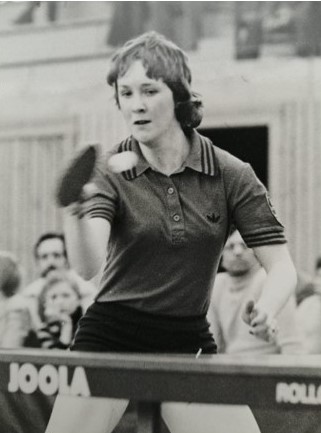
Meanwhile the Irish doubtless prepared differently. Top English player and crowd-puller Chester Barnes had been drafted in as an “honorary Irishman”; our team was therefore billed as an Irish Select rather than Ireland. The 3 mainstays of our men’s team played – Jim Langan, Tommy Caffrey, and Cliff Thompson, together with our No.1 lady Kyra Stewart and the up and coming Karen Senior, for whom it was her first Irish honour.
The spectators were treated to an extravaganza the like of which had not been seen in Ireland before. Barnes won 1 of his 2 matches, Jim and Kyra each won their singles, and China won 4-3. But that doesn’t even begin to tell the story. The Irish Independent hailed a “great victory for Langan”, who beat a future (1973) World singles champion 2-0. As usual Jim had deployed his aggressive sidespin push to telling effect, using it to create openings for point-winning topspins time after time.
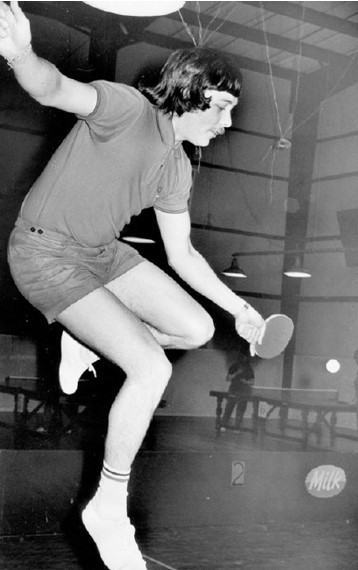
Interestingly, the Belfast Telegraph reporter Sammy Hamill, himself a close and knowledgeable follower of table tennis, had a different take on the evening’s events. He described it as the friendliest international match he had ever seen, and that the Chinese generosity extended on to the table. He said they clearly played within themselves and gave the Irish team opportunities to show what they could do, not using their best serves and giving the ball a little more air over the net. Karen has told me recently that she felt her opponent, a World Championship gold medallist, did her best to make the match competitive, for which gesture Karen was suitably appreciative!
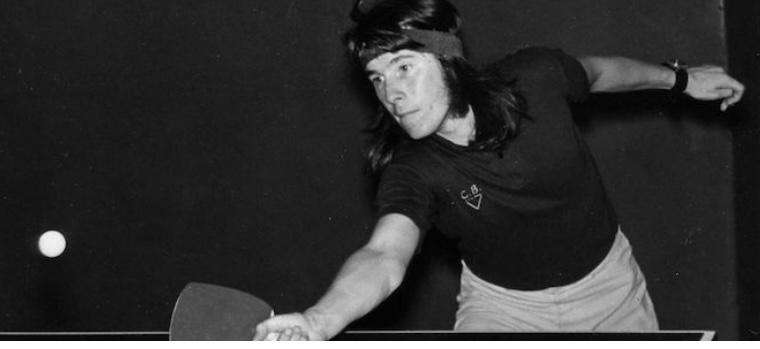
The showman Chester lost his first match in 3 close games and won his second deuce in the third. He was cheered to the echo, unusual for an Englishman in Dublin! – but in keeping with his flamboyant reputation he marked the occasion by coming out to play dressed in green. Kyra won her match 2-1 and described it, not unnaturally, as the best win of her career. There is no doubt that her play had benefitted considerably by recently having 3 months of intensive training in Japan.
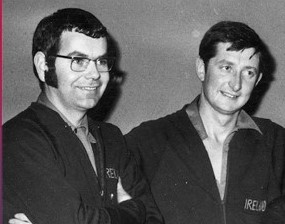
There were fewer fireworks when Tommy lost 2-0, the Irish Independent correspondent mentioning that he had not been at his best, but to be fair, against this class of opponent intent on winning, it scarcely mattered. Interestingly, GeLiang returned to Dublin for the 1992 World Veterans Championships and won gold in both over-40s singles and doubles, beating legendary French player Jacques Secretin in the singles. When Ireland’s best defender Cliff played, the result was never in doubt, but there were some incredible rallies, most lost by Cliff but the crowd was delighted by his athleticism. On one occasion he ended up flat on the floor, Chang-Chun came round to help him up, and later in a moment of comedy he pushed the table back several feet in case the large playing arena was too small for Cliff’s defensive heroics!
As if the 7 “official” matches didn’t provide enough entertainment for the night, we were then treated to a totally unbelievable exhibition match between Kuang and En-Ting. Having thoroughly enjoyed the advertised “main event”, we were spellbound and almost mesmerised by the power, the subtlety, the precision, and just the magnificence of their shots, their retrieving skills, their accuracy of placement. It did make us wonder just how much they had held back when playing the Irish, and the extent to which they had “allowed” certain results to occur. This exhibition was intended to be a single game, but, almost like a concert, the crowd wanted an encore, shouted for more, and the protagonists eventually came back to satisfy us with a second game.
And then it was over. The team from the People’s Republic of China had fulfilled their commitment, they had entertained us, they had shown us table tennis at a level about which we could only dream, they seemed to enjoy the experience, they made friends on and off the table, and we were privileged to have seen a wonderful night’s play.
MATCH SCORES (various reports give different spellings for the Chinese names and I have taken the spelling from the internet, I apologise for any errors): –
- Chester Barnes lost Tia Wen-Yuan 21-17 12-21 15-21.
- Jim Langan beat Xi En-Ting 21-19 21-17
- Tommy Caffrey lost Liang GeLiang 16-21 13-21
- Chester Barnes beat Li Ching Kuang 21-16 19-21 23-21
- Cliff Thompson lost Yu Chang-Chun 14-21 14-21
- Kyra Stewart beat Huang Hshi-Ping 20-22 21-17 21-12
- Karen Senior lost Li Li 9-21 12-21
A final anecdote – I cannot swear that this is true, but it was widely talked about in the aftermath of the Chinese match, and most of us who were around at the time believe it, so here goes! Apparently, allegedly, and whatever other caveat I need to insert, Jim Langan had done his homework on the extent of the Chinese friendship during the tour and had realised that they were losing matches every night while still ensuring overall victories. He reckoned that as the official Irish No.1 he was likely to be the beneficiary of their largesse, so he wandered in to one (or more) of the local bookies’ establishments and placed a small(!) wager on himself to win his match, at rather attractive odds.
Part 2 – travelling to the match
CHINESE MEMORIES – 50 YEARS ON.
Some of it I remember so well, some is hazy, but that is natural after such a long time. Let’s face it, how could I be expected to have total recall of even such a seismic event?
Preparations had been made meticulously. I had begged the loan of my dad’s Morris Minor TOI 1910 (I was allowed it again after trying to write off it, myself, and 5 – yes 5 – passengers 2 years earlier. Forgiveness took a while and indeed I hadn’t driven for a full year after rolling the aforesaid Morris 6 weeks after passing my test).
I had booked hotel accommodation in central Dublin, and future Irish international Stephen Tracey put his life in my hands by agreeing to come with me. We set off for Dublin. I was still renowned for having a heavy foot on the accelerator, the speedo on the Morris went up to 90 – a considerable number back then – and I regarded that figure as an ambition rather than a notional maximum.
We had an M1 even then, but across the border there was mainly 2-way traffic and no motorway, it was usual to take a back route via Slane and Ardee. One stretch of road was wide, only 1 lane each way but with an expansive hard shoulder on either side. I was passing a lorry, doing between 80 and 90 – probably nearer the latter – when a car came out of nowhere (as cars do) and we were heading for each other. I couldn’t get past the lorry to get back in, I was fully alongside it and didn’t have enough time to brake and pull in behind it, so the only option was to go onto the hard shoulder on the right, which had loose stones so I couldn’t brake and had to maintain speed. At one stage therefore the 3 vehicles were in line, even now I can see the scenario and panic. No bother in the end, I somehow kept control of the car, pulled back onto the left, and resumed in front of the lorry. I seem to recall that the remainder of the journey was pretty quiet!
We arrived early in Dublin and drove to the National Stadium. The teams were there already, the doors were open, and we wandered in to see what was going on. We watched in disbelief as the Chinese were practising with bats held together with sticky tape and with rubber which looked like old car tyres! “They couldn’t play with that rubbish”, was our unspoken thought. We soon learnt our error.
One of the Chinese players was knocking up with one of the Irish squad, and all seemed normal until the Chinese guy, who was slightly back from the table, played an exaggerated sidespin shot. His position was such that the actual point of impact was slightly masked from our player, who was however able to gauge from the arm movement what spin was on it. The ball went fairly high, he moved in to kill it, and of course it broke the other way, with just as much spin as he had anticipated but in the “wrong” direction. This looked like a fluke, until he did it again…… and again. Whichever way the ball was hit it broke with opposite spin. The (unnamed!) Irish player never once worked the shot out.
This was a completely new concept to us, personally I have no idea how that deceit worked, but I have often wondered if it was that day when Stephen got the idea for the shot that he later worked on. Same idea, same deception, and it became known in Ireland as “The Riddler”. Stephen used it to great effect.
After the match we went back to our hotel room, got up for breakfast the next morning, and drove back to Belfast, with one small addition. I hadn’t been careful about where I parked, and there was a “ticket” on the car windscreen. I thought about making a payment, then reckoned it would be some time before I was likely to return, my dad probably wouldn’t be in Dublin for a while, and the chances were there wouldn’t be an APB out for the driver of TOI 1910. I think after 50 years I’ve probably got away with it!
The match itself was a wonderful experience, I wouldn’t have missed it for anything, and it opened my eyes to a higher standard of play than I would have thought possible. Sadly it didn’t help me to achieve an ambition of playing for Ireland – some things are just impossible.
